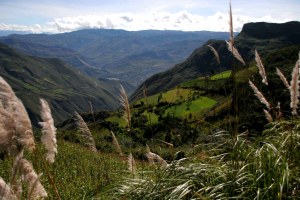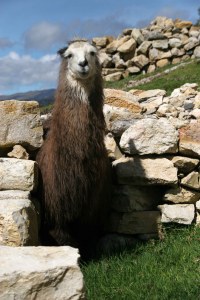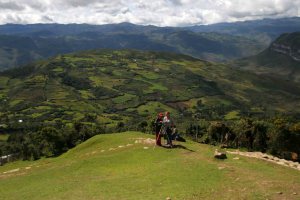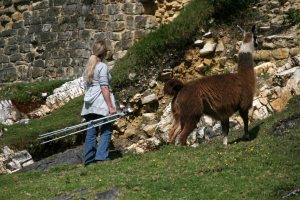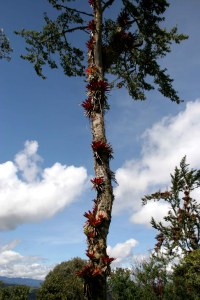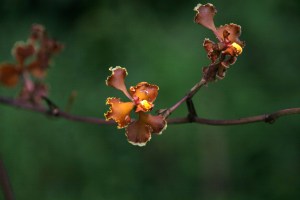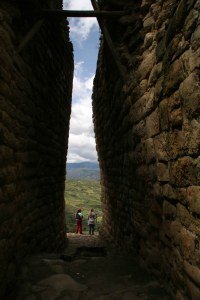It’s a lovely morning in Maria, with bright, strong light from the start. I go out onto the little balcony early. It’s still quite cool, and the countryside looks great. I stand listento the sounds and sights of a small mountain town awakening.
After coffee and a bit of breakfast, we drive to Kuelap, a little late for our 9:30 appointment with Clotilde, the guide.
At Kuelap, we’re happy to see our friends the llamas again. El rey de las llamas is still perched regally on top of the sand-pile. When we start for the far entrance, they trail after us, curious but too shy to come right up to us. One walks along with Ragna for awhile, and with her carrying her tripod and videocamera he looks as if he’s her location scout. (This shot will fit with yesterday’s shot of her producer looking over her shoulder in Tingo and the shots of the camera-repairmonkey in Tarapoto.
Kuelap is, of course, beautiful. The Chachapoya built circular houses, in tune with nature, and viewed the earth as their Mother. The Inca built rectangular buildings with sharp, artificial corners. There are a few later rectangular structures, or the ruins of them, in Kuelap, evidence of the Inca domination near the end of the pre-Columbian times.
It’s a fine spot. In its magnificence I recall Palenque, which enthralled me; and also Ganden, in Tibet. Like the Chachapoya and the Inca, the Tibetans sure could pick the magnificent mountain vistas. Spots we’d pay a lot to camp a few days in, let alone spend months or years or lives there, in contemplation and meditation.
[Digression: To spend a day in Ganden, more than twenty years ago, was an enthralling but bittersweet experience. It had been one of the three major monasteries in the Lhasa area when the Chinese invaded. Sera had cooperated with the Chinese, and remained a functioning monastery, with the buildings in fine shape, even if the population of monks was lower than before. Drepung, larger and a little further outside Lhasa, had resisted initially, and buildings ruined by artillery were mixed in with buildings still in use, although the former population of 10,000 or more monks had dwindled to a few hundred. Ganden, perched on a high hill difficult to reach even years later, had resisted and been destroyed. It was a beautiful ghost town, with such still air and such magnificent views – such a natural sacredness – that my guess was that the monks there were high on it, that its peace and beauty blinded them to the reality that the only possible result of resistance to the Chinese would be destruction. As I walk through Kuelap, enjoyhing the mountain stillness, I resolve to toss a page on Ganden into the blog when I have the chance.]
The Keulap ruins qua ruins are fine, and interesting. The high outer wall. Security features such as the extraordinarily narrow inward passageways, designed so that only one enemy at a time could pass through them – and so that he could easily be captured once he entered, if he had not been speared or hammered on the head from above with some sort of weapon while attempting the passageway. The torreon with a tremendous view. The sheer drop on one side.
The circular houses; the kitchens and burial sites, and the watch-towers are interesting. That these folks buried their family dead in holes under their homes interests me. Along with the occasional exhibition of the mummies of honored dead buried in such cliffs as Karajia, it reminds me that for these folks life and death were not so isolated from each other as in modern western civilization.
Me, I’ll be cremated. As my father said near the end of his life, “Don’t bury my body and go visit it, because I won’t be there.” The body’s a shell we use for our allotted decades. But if one is going to regard it as an important part of the person we loved, and to honor him or her through it, there’s something appealing about having it near home, not in some cold and distant graveyard we rarely visit – although I suppose the Chachapoya way wouldn’t work too well in civilizations as marked by transience and mobility as ours.
Kuelap is the informative remains of a culture, but it is also a marvelous nursery for great trees and an extraordinary concentration of orchids and bromeliads. While our guide rattles on in Spanish to Ragna, I’m as attentive to all that as a nine-year-old watching the birds through his schoolroom windows during a math lesson. I wander around staring at bromeliads and orchids, and contemplate their coexistence with these ruins.
We return to Maria. We eat lunch, then wander to the far end of town with a couple of local acquaintances to see if the little textiles museum is open and the old spinning wheel in operation. The place is closed, but one of our acquaintances inquires about someone’s whereabouts, and someone else goes to fetch a woman who has a key and can run the wheel, and who spins briefly for Ragna’s video-camera.
We like the town a lot, but Ragna doesn’t care to spend another night in the cold hostal room, and we have a long trip before us to Cajamarca, so we decide to leave, even though it’s already mid-afternoon. Simon, a young Canadian traveler lounging outside another hostal with his back-pack is headed up to Chachapoyas, so we take him as far as Tingo, swapping anecdotes and information from our travels.
After Tingo we descend to the road toward Leimebamba, which runs beside a wonderfully peaceful green river.
We will pass the hotel that Oscar, the fellow we met in Tingo the previous day, owns and is selling, and his “you have to see it” as an answer to my question about the price has given me some interest in stopping to see it; and just as Ragna is telling me she wouldn’t mind finding a restroom, we reach the front gates of the hotel, Estancia Chilco. It’s indeed in a wonderful spot, with green hills behind it and the green river running in front of it, on the other side of the road. We go in to visit with Oscar, and I shoot a bunch of photographs and ask him questions about the price. [Note: some months passed between this day and the day in Arequipa when published this on the Internet. I e-mailed Oscar to ask whether he was still selling the place, had changed his mind, or had sold it already – and never heard back.]
The place is interesting. It’s a comfortable and pleasant hotel in a tranquil spot, not to inconvenient too Kuelap, and probably a good jumping off point for a bunch of other interesting stuff in this area that most folks, including us, never see. It’s unique, in the way Oscar’s built things – and while a few points would probably be a little off-putting to some tourists, most is imaginative and relaxing in a way I’d find appealing. For someone – with a little more money than we have, and a little more determined to settle down in a quiet and very isolated place – this’d be a hell of a delightful buy: a place to semi-retire, far away from everything, but with an income too. Of course, I have no clue as to the actual work-load, since it’s far from various kinds of supplies; but someone looking for a place to buy a business in Peru and semi-retire in a part of the world that’s interesting and peaceful, ought to consider this place. It’s really isolated, with Chachapoyas the nearest city of any size, and the road to that from the north isn’t yet paved; but it looks like a comfortable place to live. [Of course, if I were buying it I’d try to buy the bit of land across the road, between road and river, which he also owns but isn’t selling; and in light of Tingo’s history, I’d at least inquire about whether or not there’s any possibility of a flood endangering the place.] Anyway, I’d recommend the place as a place to stay for anyone passing through the area and able to spend $40 per night for lodging; anyone planning to pass through with plenty of time might want to contact Oscar and inquire about what else there is to do and see in the area besides Kuelap and the museum in Leimebamba; or just check out the hotel’s web-site. [See Travel Notes, below.]
The flowing river suggests that rafting would be a good thing to do here – although what we see of this river looks too mild for accomplished rafters, a day or half-day on the river would be delightful for folks looking more to enjoy the countryside than to experience a sporting challenge.
Oscar recommends a hotel in Leimebamba, and we set off again, reaching Leimebamba just after dark because of our late start.
Leimebamba has a reputation for exceptional friendliness, and we experience it first-hand. At a crossroads as we approach it, Ragna needs to use a restroom again, but there’s no such thing as a gas station and the only restaurant in sight is closed. A shop owner says he has none at his place; but he leaves the shop, locates the friend or relative who owns the restaurant, and stands by the car shooting the breeze with me about the Golden Gate Bridge while the restaurant woman unlocks the door and takes Ragna inside. Kind. And my offer to pay a little was cheerfully rejected.
The streets in the center of Leimebamba are all torn up, and finding our way to the hotel is difficult. In the Plaza a man volunteers to assist us, and points the way we should go, then meets us on the next street and leads us to the hotel. He turns out to be the owner, and we wonder whether Oscar had called him and told him we were coming or whether he just spends a lot of time in the Plaza knowing that visitors will often be looking for his hotel and may give up before they find it.
It’s a pleasant hotel, basic but clean. When we set out to get something to eat, it’s a nice walk, and we experience more of Leimebamba’s reputed friendliness. We start down a street off the Plaza de Armas toward a restaurant [Cely’s Pizza, I think, which we understand has more than pizza], and when we ask a woman whether we’re on the right road, she says we are, but that the place may be closed. Disappointing news to two tired and hungry foreigners. She thinks the owner is sick today. She hollers to a kid playing football [soccer] in the streets to go check. He returns, and confirms that the restaurant is closed but advises us that Cely will now open it for us. She does, and greets us warmly.
It’s a very small and basic place. We feel grateful to the woman and kid for making contact for us, and to Cely for opening – but also wonder what she was sick with and whether we’ll catch it. We’re certainly going to eat there, though; and after we order, we sit watching the street-football game whenever the action passes the front door of the restaurant. The food turns out to taste just fine, and we do not catch whatever Cely was sick with that day. At any rate, the incident (along with the innkeeper’s assistance to us in navigating the streets) confirms the town’s reputation for exceptional friendliness. The population is just 1100 and the elevation 2050 meters, so Leimebamba meets my test for a congenial town, it’s altitude exceeding its population by a comfortable margin. I’d not mind staying longer.
Meanwhile, I’m still thinking about the People of the Clouds. We know that they set great store by their ancestors. Not only did they create such amazing “burial cliffs” as the ones we saw at Pueblo del los Muertos and Karajia, they kept their dead under their homes and sometimes in the walls of their citadels. During roughly 800-1540, they numbered 300,000 or more, spread out in a loose confederation throughout this beautiful mountain territory.
They were into shamanism, hallucinogenic plants, and the arts, but were shrewd, too. History suggests that they were great merchants but also had a deeply artistic temperament and deep love and respect for nature. I’d have liked to live with them awhile!
In Maria, the Mirador is probably the pick of the litter – we ate all our meals there, and enjoyed the people, the view, and the food, though it ain’t no gourmet restaurant. Nice folks.
We had a simple but quite good meal in Leimebamba at Cely’s Pizza, La Verdad 530. [see above.] Nice folks there too!
Other Points:
The museum a few kilometers south of Leimebamba is worth visiting. [See discussion in next entry.] If you don’t see the mummies, ask for ‘em.
And a book to recommend: Warriors of the Clouds, by Keith Muscutt. Subtitled “A Lost Civilization in the Upper Andes of Peru.” In the author’s words, “about the Chachapoya, sometimes called the Cloud People, the creators of a little-known civilization that flourished about a thousand years ago in a remote region of the upper Amazon, . . . also about the people who now inhabit the same region: some descendants of indigenous people, some descendants of their European conquerors, and most descants of both.” Muscatt wandered into the area in his youthful and presumably hippie days. He came to love the countryside and the people, and to learn more about it, and to try to be of help to the folks there. Combines exploration and photos with history in a readable way, and certainly he knows what he’s writing about.


